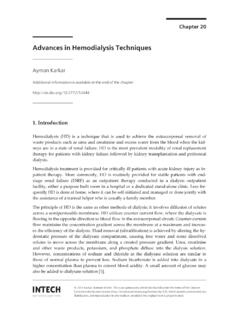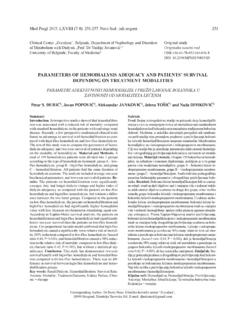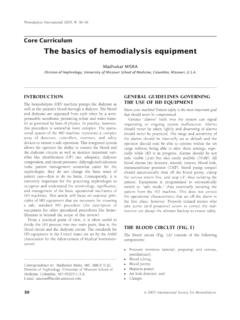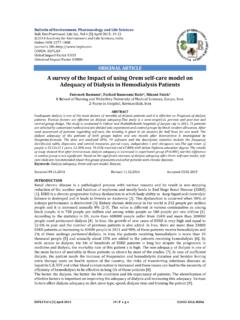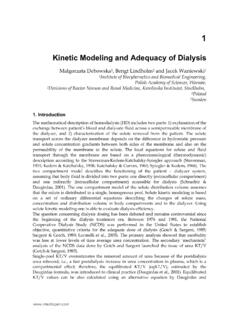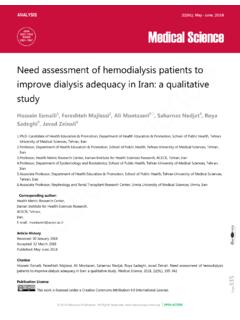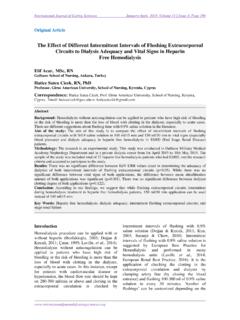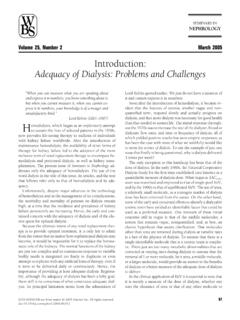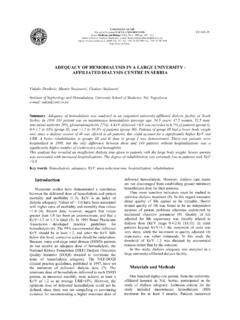Transcription of Measurement of Hemodialysis Adequacy in a Changing World
1 Defining Adequacy of dialysis remains an elusive application of the Kt/Vurea concept to clinicaldialysis was a major improvement in trying to define a dialysisdose. Intuitively, the Kt/V concept makes a great deal of sense:the urea clearance of the dialyzer during dialysis (K),multiplied by the time (t) of dialysis, divided by the patient surea distribution volume (V) ought to give the best numberto compare the efficiency of dialyses that patients are, however, many pitfalls associated with the wholeKt/Vurea concept.(Home Hemodial Int, Vol. 3, 13 15, 1999)Key wordsAdequacy, Kt/V, direct dialysis quantification, length ofhemodialysisIntroductionKt/V in itself does not define Adequacy ; it onlyestablishes that a certain quantity of dialysis was delivered,and even that uncertainly.
2 It assumes that urea generation,retention, and elimination reflect those of other toxins andthat the most important toxins are those of small molecularweight. It does so through a mathematical trick thatassumes that using concentration changes of ureaestablishes the mass removed. To do so, several assump-tions are made about urea production, removal by otherroutes, and distribution in body compartments duringdialysis. It also assumes that all these factors are the samein all patients. This final assumption throws doubt on thewhole concept. The many Kt/Vurea formulas with markedlydifferent outcomes point out that even minimally differentphysiological assumptions made by different investigatorshave major effects on the resulting Kt/Vurea number [1].
3 Movilli has pointed out that there are now well over adozen equations with different assumptions of theinfluence of ultrafiltration, urea generation rate, and dis-equilibrium that lead to a variation as great as 50% [1].Furthermore, Kt/Vurea assumes that the required dose ofdialysis is proportional to the total body using Kt/Vurea with various dialysis methodsKt/V is difficult to use for continuous dialysis methods, sinceit requires a separate Measurement of K and calculation of , V must be calculated from formulas developedin subjects without renal failure [2,3]. Finally, V calculatedwith these two formulas does not give the same result in thesame the frequency of dialysis increases, Kt/Vurea cannot becompared by simply adding individual dialysis results for aweekly total.
4 It cannot be compared or added to remainingrenal function without several new assumptions and com-plicated mathematical formulas [4,5]. The mathematicalsophistication and convoluted terminology have reachedbizarre levels and have inclined many to use a simple ureareduction ratio or to ignore Kt/Vurea totally, relying only onpredialysis blood urea nitrogen concentration and time ofdialysis. The use of poorly defined and differently measuredKt/Vurea to compare widely divergent patient populations indifferent countries makes the confusion worse. Things arenot getting easier, as the frequency of dialysis reenters as amajor contributor to dialysis Adequacy and patient well-being;the more often the patients are dialyzed, the better off theyare, even if Kt/Vurea is lowered or held constant [6 9].
5 Problems with using Kt/Vurea for adequacyIn some careful studies, where sophisticated statisticaltechniques have been used to ensure that other factors thatmay influence outcome remain constant, even fairly largevariations in Kt/Vurea have had no influence on outcome[10,11]. There has never been unanimity on how to measureKt/V, how long to wait for urea equilibration, and what factorsto put in for urea generation, disequilibrium, or extrarenalremoval. The assumption that all patients behave similarly inall these respects is physiological is also hard to accept the DOQI (Dialysis OutcomesQuality Initiative) guidelines that a Kt/Vurea of (single poolmodel) or (double pool) if used three times per week isadequate [12].
6 Both Charra in France [13] and results fromthe Japanese dialysis registry [14], including over 100 000patients, show improvement in survival with increasingKt/Vurea, that goes beyond a Kt/Vurea of used three timesper week. Still, for all its problems, Kt/V remains a parameterthat is much superior to predialysis blood urea nitrogen (BUN).It is clear that concentration Measurement of predialysis ureais not enough. The most lethal combination in dialysis isCorrespondence to:Carl Kjellstrand, MD, Aksys, Ltd., 2 Marriott Drive, Lincolnshire,Illinois 60069 : of HemodialysisAdequacy in a Changing WorldCarl M. Kjellstrand,1 Zbylut J. Twardowski2 Aksys, Ltd.
7 ,1 Lincolnshire, Illinois; University of Alberta,1 Edmonton, Alberta, Canada; State University of New York,1 Loyola University1; University of Missouri,2 Dalton ResearchCenter,2 Dialysis Clinic, Inc.,2 Columbia, Missouri, AdequacyHome Hemodialysis International, Vol. 3, 1999underdialysis and protein malnutrition, yet patients with thesecharacteristics have the same predialysis BUN as well-dialyzed patients with a high protein and length of dialysisIn a given patient V is essentially stable and Kt/V may beincreased by increasing K or t or both. Kt may be increasedwith shorter time, if the increase in K overcompensates forthe drop in t. An assumption that the outcome in dialysispatients depends only on Kt/V inclined nephrologists toincrease efficiency of dialysis and shorten dialysis time.
8 Suchan approach neglected the importance of removal of middlemolecules and other substances like phosphorus, which havepoor transcellular diffusibility. Even more importantly, shortdialysis time precludes achievement of true dry body weightand control of blood pressure [15]. Good control of bloodpressure decreases cardiovascular morbidity, which is by farthe leading cause of death in dialysis patients [15]. Adequacy and dialysis frequencyThe escalating interest in increasing dialysis frequency nowbrings even more complexity to the definition of optimal oradequate dialysis. The results of many clinical studies with acumulative total of over 200 patients clearly show thatincreasing dialysis frequency is more important than in-creasing time and Kt/Vurea of dialysis for patient well-being[6 9,16].
9 However, how to express the beneficial effects ofincreased frequency remains unknown. In the mid-1970s theeradication of clinical symptoms of uremia, acceptablehematocrit without the need of blood transfusions, well-controlled blood pressure without blood pressure medications,normal nerve conduction velocity, and good nutrition, asjudged by serum albumin, were considered as indicatingadequate therapy [17,18]. Another approach at that time wasthe design of an index combining blood pressure values,weight gains, urea and creatinine variations, and potassiumchanges [19]. Lopot and Valek have more recently suggestedthe use of time-averaged deviation of urea, as a measure ofthe unphysiology of intermittent Hemodialysis [20].
10 A thirdattempt, to mathematically increase Kt/Vurea as frequencyincreases, the standardized Kt/Vurea (std Kt/Vurea) [4], seemstotally inadequate since it is not based on clinical correlationsand will only add more confusion to an already decades ago, it was clear that increasing thefrequency of dialysis was much more important than increasingthe dose [6 8]. The improvement that followed the increasedfrequency by far exceeded what one can expect by applyingthe std Kt/Vurea concept to these data [6 8]. There are manyother factors that need to be considered, measured, andmathematically expressed to create an index of the unphysi-ology of intermittent Hemodialysis .

